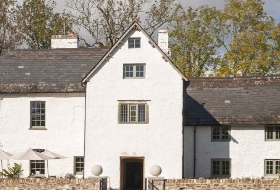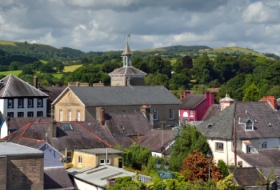Applying for listed building consent
Page updated on: 08/04/2025
The Listed Building Consent process is managed through Carmarthenshire’s planning department. The Development Management Officer for the area in which the listed structure is sited will be the case officer for the Listed Building application, but will consult the Built Heritage Officer as part of the review of the application.
The Built Heritage Officer will review the application material and possibly visit the site, and ultimately make a decision on whether to recommend the application for approval. This recommendation will be based upon a variety of factors which will include the appropriateness of the proposal and the national and local policy frameworks. Relevant policies include Planning Policy Wales 10th Edition, Technical Advice Note (TAN)24 and Local Development Strategies (LDS 13).
Before you make an application for Listed Building Consent you may well also benefit from attending the Tywi Centre course ‘Listed Building Consent: a step-by-step guide to making changes to your historic home’.
As well as providing a ready reference of buildings of importance, listing provides an added level of protection. This is in a form of a special planning procedure, known as listed building consent. Before a listed building can be altered, extended or demolished, it is likely to be necessary to obtain listed building consent. It is a criminal offence to alter, extend or demolish a listed building in any manner that would affect its character as a building of special architectural or historic interest without listed building consent.
The need for consent applies to works to all parts of the building, interior or exterior, regardless of grade and whether the feature is mentioned in the official list description. It may also apply to associated buildings that are within the curtilage of the principal building.
Consent is not usually required for routine repairs or maintenance, however, it advised to contact the built heritage team to discuss your proposals.
Listed Building Consent relates solely to making alterations to a listed building. You may also need planning permission and building regulations approval for some works, for example where works will have an impact on the external appearance of the building; the use of the building is to be changed; or new structures in the near vicinity of the building, and should be applied for at the same time.
Listed building consent is additional to and separate from planning permission and building regulations approval. The granting of planning permission will not mean that listed building consent will necessarily be granted. If other permissions are required, you should make the applications at the same time.
To find out if planning permission is required for your project please contact the Development Management Officer in your area.
Applications are made to the appropriate local planning authority in whose area the building is situated. The application form is found through the Planning Portal. The authority will examine the case against guidelines issued by the Welsh Government (the relevant policies can be seen on the Cadw website) and in the light of its local policies for the protection of the historic environment. In all cases, there will be a presumption in favour of preservation of as much of the historic fabric of a building as possible. The application will be publicised locally by the local authority, and, in the case of demolition (which may include partial demolition), national amenity bodies will be notified.
In Carmarthenshire applications for buildings for Grade II will be determined by the Local Planning Authority. The decision to recommend approval on Grade II does not need to be sent to the Welsh Government for their review.
Grade II* and Grade I buildings in Carmarthenshire will be assessed by the Local Planning Authority, but every application of these grades recommended for approval will be forwarded to the Welsh Government for their review. If they are not happy with the decision they have the opportunity to ‘call in’ the application for further scrutiny.
If consent is refused it is possible to make an appeal.
Listed Building Consent is free to apply for; however, if you also require additional permissions (such as Planning Permission), then this part of the application will incur a fee.
Details of different planning application costs can be found on our website.
Listed Building Consent for a Grade II listed building usually takes up to eight weeks to determine from when the application is registered as a complete application, to final determination. Listed Building Consent for Grade II* and Grade I structures and buildings usually takes longer as Cadw are involved in the approval process.
However, applications can take longer as additional information may well need to be supplied by the applicant during the review period to enable the Local Planning Authority to make the best informed decision.
Proceeding with works that require consent before the application has been determined is a criminal offence.
Sometimes the Local Planning Authority may grant Listed Building Consent, but impose conditions where they require extra information or more detail before work starts on the property. A list of these conditions will be included in the decision notice. You will need to discharge each of these conditions prior to works commencing, which will require an additional application.
Where there is uncertainty about the need for consent, it would be advisable to contact the Built Heritage Team before preparing detailed plans to avoid incurring unnecessary costs. In addition, it may be appropriate to consult or employ an architect, surveyor or planning agent with conservation experience.
Further information on how to apply online and download application forms can be viewed on our Submit a planning application webpage.
Your application must be complete and well documented so that it can be considered in an effective and timely way by the local planning authority. You should provide the local planning authority with relevant and sufficient information to allow the assessment of the likely impact of the proposals on the special architectural and/or historic interest of the listed building and on its setting.
Cadw has produced a series of publications to help you understand and care for historic buildings and these are available on their website. More specifically the document entitled Managing Change to Listed Buildings provides information to assist you in making an application. In the Annex of Managing Change to Listed Buildings there is a checklist of supporting documents you will need to include as part of a listed building consent application. This checklist has been reproduced below. Not all documents will be needed in every case; conversely, additional supporting documents may sometimes be required, such as an archaeological assessment; structural surveys; schedule of works; or window condition reports. Documents submitted with the application should be relevant to the proposed works; for example, it is unlikely that you would need to submit floor plans for alterations to windows.
Always check with your local planning authority to establish whether it requires additional information.
- Application Form. Completed Listed Building Consent application form
- Certificate of Ownership. Your application must be accompanied by a certificate identifying you as owner, or as having served notice on the owner
- Heritage Impact Statement. Your heritage impact statement should summarise the proposed works and explain what they are intended to achieve, the significance of the asset and the aspects of its value most directly affected. It should assess the impact of the proposal, including potential benefits as well as harm. The assessment should be proportionate to the proposals and their likely impact.
- Location Map. At scale 1:1,250 or 1:2,500. Buildings to be affected should be outlined in red and neighbouring land in the same ownership in blue.
- Plans. At each floor level, scale 1:50 (1:100 for large buildings). Separate drawings to showing existing and proposed situations. Digital plans should make reference to the paper size.
- Elevations and Sections. External alterations must be shown on existing and proposed elevations, and internal alterations on similar sections, both at the same scale as the plans.
- Details. For works affecting larger scale features; for example, doors, windows, railings and staircases, drawings at 1:10 and 1:20. For fine and more decorative details; for example, stone mouldings, wooden glazing bars, plaster details, and intricate metalwork, drawings at scale 1:2 or 1:1.
- Photographs. Dated photographs showing the existing appearance of those parts of the building and its setting to be affected must be included. Photomontages showing the visual effects of proposed changes can be used for minor works; for example, addition of lights, aerials, alarms, or changes to shopfronts and signage. The wider setting of the listed building should be shown on more distant photographs.
- Ecology. Where appropriate, a statement must be included on what ecological constraints were considered. Ecological survey results and recommendations should be attached to the application.
- Specialist Reports. As requested by the local planning authority.
- Design and Access Statement. A design and access statement may be required to support planning applications. Further guidance is available in Design and Access Statements in Wales
Under new regulations that came into force on 1 September 2017, a heritage impact statement is required to support listed building and conservation area consent applications.
Your heritage impact statement should:
- Describe the significance of the affected part of your listed building
- Explain the proposed work, with reference to any accompanying photographs, plans and drawings, what you intend to achieve and why the works are desirable or necessary.
- Assess the impact of the proposed work.
- Show how and why the preferred design for the alterations or extensions was chosen, including any measures to reduce harm.
- Include an access statement in relation to any works which affect the access arrangements to, or within, any part of your listed building that is not used as a private dwelling.
- Be proportionate to the proposals and their likely impact; for example, a major restoration scheme will need more detailed consideration than an application to paint a previously unpainted building.
In order to produce a Heritage Impact Statement it is likely that you will need to undertake a full assessment of the heritage asset you are proposing to alter and guidance on producing a Heritage Impact Assessment can be downloaded from the Cadw website.
Understanding the significance of a building is about understanding the elements of that building which are historically important and are worthy of attention and protection.
The download below shows the range of elements which can contribute to building up a picture of the historic significance of a listed structure. An assessment of significance is the first part of a Historic Impact Assessment (HIA): without knowing what parts of a building and its setting are the most historically significant, it is very hard to know the implications of any proposed work to a building.
Not all structures or buildings will demonstrate all the values and characteristics in the download below, but each should be considered and the HIA should document the results.
According to Cadw’s Conservation Principles, Local Planning Authorities are expected to make decisions about changes by applying expertise, experience and judgement in a consistent and transparent process, guided by law and policy.
In practice, this means that they will take into account the significance of the historic building for which consent is being sought, and judge the impact of those changes to the building. They will make their decisions in light of national and local policies and guidelines. In assessing an application the Local Planning Authority will ensure that they have enough information from you as an applicant in order to make a fully informed decision.
Public engagement will also inform and justify the decisions that they make.
Public authorities are expected to give due importance to the heritage values of a site when considering the suitability of proposals submitted to them.





